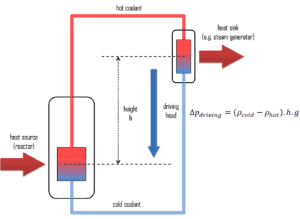Natural Circulation in Reactor Engineering

In reactor engineering, natural circulation is very desired phenomenon, since it is capable to provide reactor core cooling after the loss of RCPs (e.g. after loss of offsite power – LOOP). In PWRs, plant design provides an elevation difference, h, of approximately 12 meters between the centerline of the steam generator and the centerline of the reactor core. The layout of the system must ensure natural circulation capability following a loss of flow to permit cooldown without overheating the core. Moreover, the interconnecting piping from the reactor pressure vessel to the steam generators must be intact, free from obstructions such as non-condensable gasses (e.g. steam pockets). In this way, natural circulation will ensure that the fluid will continue to flow as long as the reactor is hotter than the heat sink, even when power cannot be supplied to the pumps.
RCPs are not usually “safety system”, as defined. After the loss of RCPs (e.g. after loss of offsite power – LOOP) the reactor must be shutdown immediately, since RCPs slowly coast down to zero flow rate. Sufficient and safe residual heat removal is then ensured by a natural circulation flow through the reactor. With no forced flow, the coolant in the core begins to heat up. The increase in coolant temperature causes a reduction in coolant density, which in turn moves the coolant into the steam generator. It must be noted, natural circulation is not sufficient to remove the heat being generated when the reactor is at power.
Modern reactor designs use natural circulation a very important safety feature. Many passive safety systems in modern reactor designs operate without using any pumps, which creates increased design safety, integrity, and reliability, while simultaneously reducing overall reactor cost.
Indicators of Natural Circulation
In PWRs, various parameters can be used to indicate or verify natural circulation is occurring. This is dependent on plant type and plant systems. For instance for a PWR selected parameters that can be used are as follows:
- Ideally, the flow rate can be measured in each of loops.
- ΔT (THot – TCold). The temperature difference between hot legs and cold legs should be 25-80% of the full power value and either steady or slowly decreasing. This indicates that the decay heat is being removed from the system at an adequate rate to maintain or reduce core temperatures.
- Hot and cold leg temperatures should be steady or slowly decreasing. Again, this indicates that heat is being removed and the decay heat load is decreasing as expected.
- Steam generator steam pressure (secondary side pressure) should be following reactor coolant system temperature. This verifies that the steam generator is removing heat from the RCS coolant.
Special Reference: Natural circulation in water cooled nuclear power plants, IAEA-TECDOC-1474. IAEA, 2005. ISBN 92–0–110605–X.
We hope, this article, Natural Circulation in Reactor Engineering, helps you. If so, give us a like in the sidebar. Main purpose of this website is to help the public to learn some interesting and important information about thermal engineering.